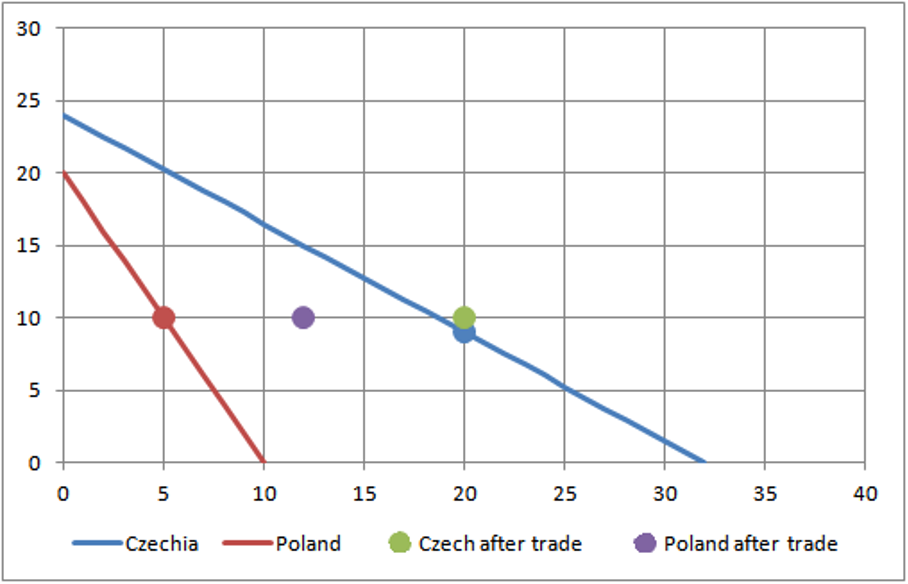Europe: Competition or Cooperation?
-
Overview
-
Background information8 Topics
-
Endnotes
-
Glossary1 Topic
-
References
-
Interactive learningDeepen your knowledge1 Quiz
-
Training materialExercises for group activities2 Topics
3. Ricardian model of trade – example
The following example shows how the theory of comparative advantage works with a fictitious example of international trade. Suppose that Czechia and Poland currently produce beer and apples. Citizens consume their own domestic products. In Poland 1 hour of labour is needed to produce 1 bottle of beer or 2 kg of apples. In Czechia 1 hour of labour is needed to produce 4 bottles of beer or 3 kg of apples. The table shows each nations efficiency in the production of beer and apples (labour productivity).
Table 1. Beer and apple productivity in Czechia and Poland.
Beer | Apples | |
Czechia | 4 | 3 |
Poland | 1 | 2 |
Clearly the Czechia workers’ productivity is higher than that of Polish workers, as during 1 hour they are able to produce more beer and more apples (Tab.1). It can be said that 1 bottle of beer is cheaper in Czechia, because it costs 0,25 of labour hour in comparison to Poland where 1 bottle of beer costs 1 labour hour. Similarly 1 kg of apples is cheaper in Czechia with the price of 0,33 labour hour than in Poland where the cost is 0,5 labour hour.
It is evident that Czechia has got an absolute advantage in production of beer and apples (Tab.2). Both of these products are just cheaper to produce in Czechia than in Poland (assuming equal cost of labour). In this situation the question arises whether Czechia should decide to produce both products domestically, or if it is still possible to achieve some gains from specialization and trade.
Table 2. Cost production (in labour hours) of one bottle of beer and one kilogram of apples in Czechia and Poland.
Beer | Apples | |
Czechia | 0,25 | 0,33 |
Poland | 1 | 0,5 |
Table 3. Maximal production of beer or apples in Czechia and Poland under specialization.
Productivity | Labour hours available | Maximal production | |||
Beer | Apples | Beer | Apples | ||
Czechia | 4 | 3 | 8 | 32 | 24 |
Poland | 1 | 2 | 10 | 10 | 20
|
Let’s assume that Czechia has got 8 hours of labour and Poland has got 10 hours of labour available. With these resources Czechia and Poland can achieve different maximal production outcomes (Tab. 3).
The results of all possible production outcomes are shown on a graph (Fig.1). Although Czechia has less resources (8 labour hours) than Poland (10 labour hours), Czechia is able to produce more beer or apples than Poland. It is so, because Czechia has got higher productivity (absolute advantage).

Let’s say that initially both countries were producing a mixed outcome of beer and apples. Czechia was producing 20 bottles of beer and 9 kg of apples. Poland was producing 5 bottles of beer and 10 kg of apples. Total production was 25 bottles of beer and 19 kg of apples. (Tab.3) Now each country decides to specialize in production of only one product. Looking at the cost of production it is clear that in Czechia, beer is relatively cheaper to produce than apples. It is Czechia’s comparative advantage. The situation is quite opposite in Poland, where production of apples is relatively cheaper than beer (Tab.2). Therefore it is Poland’s comparative advantage. Therefore it seems obvious that Czechia chooses to produce beer and Poland chooses to produce apples.
Table 3. Initial mixed production of beer and apples in Czechia and Poland.
Beer | Apples | |
Czechia | 20 | 9 |
Poland | 5 | 10 |
Total production | 25 | 19 |
After specialization, total production of beer and apples rises (Tab.4). In total there are 32 bottles of beer in comparison to 25 before, and 20 kg of apples in comparison to 19kg before. The question is how to exchange goods between countries to fulfill their domestic demand. If Czechia wanted to have 20 bottles of beer and Poland wanted to have 10 kg of apples, the excess production can be traded. With this assumption an excess production of beer in Czechia (32 – 20 = 12) can be exchanged for apples. Similarly in Poland an excess production of apples (20 – 10 = 10) can be exchanged for beer. As a result, Czechia can export up to 12 bottles of beer to Poland and Poland can export up to 10 kg of apples (Tab. 5).
Table 4. Production of beer and apples in Czechia and Poland after specialization.
Beer | Apples | |
Czechia | 32 | 0 |
Poland | 0 | 20 |
Total production | 32 | 20 |
Finally, it is a matter of negotiations how many bottles of beer Czechia sends to Poland in exchange for 10 kg of apples. Czechia can decide to export 12 bottles of beer or less for 10 kg of apples from Poland. Nevertheless, with specialization and international trade both countries are in a better situation than before. The volume of consumption in Czechia and Poland is higher than was possible without exchange (Fig.2).
Table 5. Initial supply, export and supply after exchange.
Initial supply | Export | Supply after exchange | ||||
Beer | Apples | Beer | Apples | Beer | Apples | |
Czechia | 20 | 9 | 12 | 0 | 20 | 10 |
Poland | 5 | 10 | 0 | 10 | 12 | 10 |
Total | 25 | 19 | 12 | 10 | 32 | 20 |







